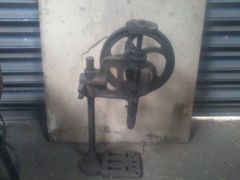-
Posts
2,139 -
Joined
-
Last visited
Content Type
Profiles
Forums
Articles
Gallery
Downloads
Events
Everything posted by the iron dwarf
-

Trying to commercially make an anvil
the iron dwarf replied to kawvalleysteel's topic in Anvils, Swage Blocks, and Mandrels
going to check some scrapyard steel in a couple of hours, will start taking a small hammer and a center punch with me to help identify steels. you can tell a bit by the ring and how hard it is to dent an edge or how far a punch goes in -

Show Me Your Antique Drill Press
the iron dwarf replied to Brenton's topic in Drills, Post drills, Mag drills, etc
here is one I have http://www.iforgeiron.com/gallery/image/38018-brad14/ it is a Bradson No 14 autofeed bench drill -

Trying to commercially make an anvil
the iron dwarf replied to kawvalleysteel's topic in Anvils, Swage Blocks, and Mandrels
VaughnT I was thinking on the first of the two anvils to get a block and machine the slot in the side, maybe even drilling the pritchel. then forging all the faces except the bottom to lose the flat sides, straight lines and sharp corners look of modern steel and only slightly mushrooming the top leaving most nearly flat, then electrolysis to add some pitting over the texture it has and lastly hammering on the top to polish it up a bit. -

Trying to commercially make an anvil
the iron dwarf replied to kawvalleysteel's topic in Anvils, Swage Blocks, and Mandrels
I might have to see how far my power hammer will go, it is only small and I have not yet found its limits. 11 kg hammer weight 100 to 120 kg total machine weight 60 kg anvil weight and a 1 hp motor that has never yet been above 35% load. will see if I can get it 100% load before something breaks -
been a bit wet and breezy here in Northants but no real problems in my area
-

Trying to commercially make an anvil
the iron dwarf replied to kawvalleysteel's topic in Anvils, Swage Blocks, and Mandrels
VaughnT I have been asked in the past to make things like your block anvils but have considered it hard to make them look 'not machine made' for reenactor friends, I have learned a few things from the resources here that may make it more possible though. I wonder how newly made they should look and things like that, how much wear and patina to add to to leave to the user to add by using them -
vises are expensive that side of the pond, I can get several good ones here that are hardly used for less
-

snowsmith
the iron dwarf replied to Old South Creations's topic in Blacksmithing, General Discussion
should be about 2 degrees C here in the morning and then another storm coming in by 10am -

snowsmith
the iron dwarf replied to Old South Creations's topic in Blacksmithing, General Discussion
he aint got a lot of muscle on them arms :D -
cut a tapered groove and as you hammer feed the work along it turning frequently
-

Anvil Alternatives
the iron dwarf replied to MrBackpack's topic in Anvils, Swage Blocks, and Mandrels
caotropheus that looks great -

Anvil Alternatives
the iron dwarf replied to MrBackpack's topic in Anvils, Swage Blocks, and Mandrels
dont worry about it, here we see the same questions most days and some of the old curmudgeons get a bit cranky, they are not so bad when you get to know them. if you have welding gear and access to a scrapyard you can make yourself a nice post anvil from a piece of rail on end with a base on it, a short piece welded at the top so the end of the short piece buts up to the flat bottom of the upright with the rounded top level with the top of the upright, now you have the top rail end for heavy hammering, the short horizontal for a gentle curve and radiused edges. on the opposite side of the upright weld on a tooth from the bucket of an excavator for your horn, then add 2 pieces of flat to the inside bottom of the top of the upright to make a hardy hole -
from the tags its in Hackney and is a railway arch, in London and a few other places a lot of the rails are well above street level and the roads are below them, the brick archways not used for roads became small workshops and storage space with regular trains overhead every few minutes. probably the same in some parts of some US cities
-
what is on the makers plate, any name or contact details?
-

Anvil Alternatives
the iron dwarf replied to MrBackpack's topic in Anvils, Swage Blocks, and Mandrels
on rail you dont have to use just the end, you can use the top, sides and bottom too -
What were the sparks like when you used the grinder on it?
-
tap the face with a small hammer and mark the different areas. the 20% to 90% rebound is an indication of how far the trouble goes
-

Is it really necessary to build your own forge?
the iron dwarf replied to ShawnW's topic in Blacksmithing, General Discussion
you could make a bean can forge for just a few $ to have a play with and you will have it as a back up later if you need it- 48 replies
-

Home build induction heater
the iron dwarf replied to Daniel.85's topic in Induction Heating, Oil forges, etc
I personally would be more interested in a kit than a completed item as this may make it easier to customize to suit local conditions like supply voltage and current available, also metric or imperial fittings, horizontal or vertical coil connections. also a kit may be easier for those of us overseas due to how much you have to send and import duties / customs fees I would like to know about actual measured current use as some places have limits. here most people have standard outlets that are 13 amps at 240 volts, bigger things are possible for industry we have 13a 240v 16a 240v 32a 240v all single phase and 16a 415v 32a 415v at 3 phase ( there are bigger but these are what is normal ) next time you are doing a video can you put a meter on to measure the current, your last vid here had a bar heated up in about 11 seconds, the text said 120v but the vid said 240v. some commercial ones seem to have oddly low current needs like a 240v 15kw unit that states 32 amp is needed when physics states it should be 62.5 amps. I would not want to buy something I cannot use due to power requirements. might I suggest that the connections for the coil are at 45 degrees, that way it is easy to make a horizontal coil or a vertical one. yes, sorry to keep bugging you but it did seem to be dragging on a bit, hope things settle down a bit for both of you soon -
it would be possible maybe. if you ground a slot in it following the crack as deep as it goes which could be 6 inches then fill the slot with weld, if the body is cast iron it will cost a fortune in rods to do this and then afterwards you will have to heat treat the anvil again. you could just use the rest of it
-

Is it really necessary to build your own forge?
the iron dwarf replied to ShawnW's topic in Blacksmithing, General Discussion
there are plans for gas forges here and experts to help you so it could be a question of just putting together a few parts and none or very little tweaking and tinkering with it to get it working right but you would learn by doing it and save a bunch of money and get a forge more in line with what you want. im no expert on gassers, I do make solid fuel forges and lots of people like to buy something ready to go- 48 replies
-

Home build induction heater
the iron dwarf replied to Daniel.85's topic in Induction Heating, Oil forges, etc
any news yet? :ph34r: -

Let's talk about magnets
the iron dwarf replied to JimsShip's topic in Blacksmithing, General Discussion
wind a coil round a tube, something non magnetic but not bothered by a little heat, place hot item inside tube and connect the coil to a dc supply, maybe blow some air through the tube so the coil does not get to hot whilst your hammer or anvil cools

